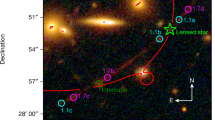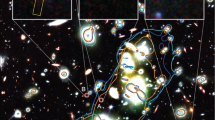Abstract
Re-ionization of the intergalactic medium occurred in the early Universe at redshift z ≈ 6–11, following the formation of the first generation of stars1. Those young galaxies (where the bulk of stars formed) at a cosmic age of less than about 500 million years (z ≲ 10) remain largely unexplored because they are at or beyond the sensitivity limits of existing large telescopes. Understanding the properties of these galaxies is critical to identifying the source of the radiation that re-ionized the intergalactic medium. Gravitational lensing by galaxy clusters allows the detection of high-redshift galaxies fainter than what otherwise could be found in the deepest images of the sky2. Here we report multiband observations of the cluster MACS J1149+2223 that have revealed (with high probability) a gravitationally magnified galaxy from the early Universe, at a redshift of z = 9.6 ± 0.2 (that is, a cosmic age of 490 ± 15 million years, or 3.6 per cent of the age of the Universe). We estimate that it formed less than 200 million years after the Big Bang (at the 95 per cent confidence level), implying a formation redshift of ≲14. Given the small sky area that our observations cover, faint galaxies seem to be abundant at such a young cosmic age, suggesting that they may be the dominant source for the early re-ionization of the intergalactic medium.
This is a preview of subscription content, access via your institution
Access options
Subscribe to this journal
Receive 51 print issues and online access
$199.00 per year
only $3.90 per issue
Buy this article
- Purchase on Springer Link
- Instant access to full article PDF
Prices may be subject to local taxes which are calculated during checkout




Similar content being viewed by others
References
Robertson, B. E., Ellis, R. S., Dunlop, J. S., McLure, R. J. & Stark, D. P. Early star-forming galaxies and the reionization of the Universe. Nature 468, 49–55 (2010)
Kneib, J.-P. & Natarajan, P. Cluster lenses. Astron. Astrophys. Rev. 19, 47–146 (2011)
Kneib, J.-P., Ellis, R. S., Santos, M. R. & Richard, J. A probable z ∼ 7 galaxy strongly lensed by the rich cluster A2218: exploring the dark ages. Astrophys. J. 607, 697–703 (2004)
Bradley, L. D. et al. Discovery of a very bright strongly lensed galaxy candidate at z ∼ 7.6. Astrophys. J. 678, 647–654 (2008)
Zheng, W. et al. Bright strongly lensed galaxies at redshift z ∼ 6–7 behind the clusters Abell 1703 and CL0024+16. Astrophys. J. 697, 1907–1917 (2009)
Richard, J. et al. Discovery of a possibly old galaxy at z = 6.027, multiply imaged by the massive cluster Abell 383. Mon. Not. R. Astron. Soc. 414, L31–L35 (2011)
Bradley, L. D. et al. Through the looking glass: bright, highly magnified galaxy candidates at z ∼ 7 behind A1703. Astrophys. J. 747, 3 (2012)
Zitrin, A. et al. CLASH: discovery of a bright z ≃ 6.2 dwarf galaxy quadruply lensed by MACS J0329.6–0211. Astrophys. J. 747, L9 (2012)
Bouwens, R. J. et al. A candidate redshift z ≈ 10 galaxy and rapid changes in that population at an age of 500 Myr. Nature 469, 504–507 (2011)
Oesch, P. A. et al. Expanded search for z ∼ 10 galaxies from HUDF09, ERS, and CANDELS data: evidence for accelerated evolution at z > 8? Astrophys. J. 745, 110 (2012)
Zackrisson, E. et al. Detecting gravitationally lensed population III galaxies with HST and JWST. Preprint at http://arxiv.org/abs/1204.0517 (2012)
Postman, M. et al. Cluster lensing and supernova survey with Hubble (CLASH): an overview. Astrophys. J. 199 (suppl.). 25 (2012)
Ebeling, H., Edge, A. C. & Henry, J. P. MACS: a quest for the most massive galaxy clusters in the universe. Astrophys. J. 553, 668–676 (2001)
Zitrin, A. & Broadhurst, T. Discovery of the largest known lensed images formed by a critically convergent lensing cluster. Astrophys. J. 703, L132–L136 (2009)
Smith, G. P. et al. Hubble space telescope observations of a spectacular new strong-lensing galaxy cluster: MACS J1149.5+2223 at z = 0.544. Astrophys. J. 707, L163–L168 (2009)
Ilbert, O. et al. Accurate photometric redshifts for the CFHT legacy survey calibrated using the VIMOS VLT deep survey. Astron. Astrophys. 457, 841–856 (2006)
Benítez, N. Bayesian photometric redshift estimation. Astrophys. J. 536, 571–583 (2000)
Koekemoer, A. M. et al. The COSMOS survey: Hubble space telescope advanced camera for surveys observations and data processing. Astrophys. J. 172 (suppl.). 196–202 (2007)
Polletta, M. et al. Spectral energy distributions of hard X-ray selected active galactic nuclei in the XMM-Newton medium deep survey. Astrophys. J. 663, 81–102 (2007)
Bruzual, G. & Charlot, S. Stellar population synthesis at the resolution of 2003. Mon. Not. R. Astron. Soc. 344, 1000–1028 (2003)
Fioc, M. & Rocca-Volmerange, B. PEGASE: a UV to NIR spectral evolution model of galaxies. application to the calibration of bright galaxy counts. Astron. Astrophys. 326, 950–962 (1997)
Wuyts, S. et al. FIREWORKS U38-to-24 μm photometry of the GOODS Chandra deep field-south: multiwavelength catalog and total infrared properties of distant K s-selected galaxies. Astrophys. J. 682 (suppl.). 985–1003 (2008)
Zitrin, A., Broadhurst, T., Barkana, R., Rephaeli, Y. & Benítez, N. Strong-lensing analysis of a complete sample of 12 MACS clusters at z > 0.5: mass models and Einstein radii. Mon. Not. R. Astron. Soc. 410, 1939–1956 (2011)
Jullo, E. et al. A Bayesian approach to strong lensing modelling of galaxy clusters. N. J. Phys. 9, 447 (2007)
Moustakas, J. et al. Evolution of the stellar mass-metallicity relation since z = 0.75. Astrophys. J.. (submitted); preprint at http://arxiv.org/abs/1112.3300 (2011)
Conroy, C. & Gunn, J. E. The propagation of uncertainties in stellar population synthesis modeling. III. model calibration, comparison, and evaluation. Astrophys. J. 712, 833–857 (2010)
Chabrier, G. Galactic stellar and substellar initial mass function. Publ. Astron. Soc. Pacif. 115, 763–795 (2003)
Labbé, I. et al. Ultradeep infrared array camera observations of sub-L* z ∼ 7 and z ∼ 8 galaxies in the Hubble ultra deep field: the contribution of low-luminosity galaxies to the stellar mass density and reionization. Astrophys. J. 708, L26–L31 (2010)
Bouwens, R. J. et al. Very blue UV-continuum slope β of low luminosity z ∼ 7 galaxies from WFC3/IR: evidence for extremely low metallicities? Astrophys. J. 708, L69–L73 (2010)
Labbé, I. et al. Star formation rates and stellar masses of z = 7–8 galaxies from IRAC observations of the WFC3/IR early release science and the HUDF fields. Astrophys. J. 716, L103–L108 (2010)
Acknowledgements
The CLASH programme (GO-12065) is based on observations made with the NASA/ESA Hubble Space Telescope. The Space Telescope Science Institute is operated by the Association of Universities for Research in Astronomy, Inc. under NASA contract NAS 5-26555. This work is also based in part on archival data obtained with the Spitzer Space Telescope, which is operated by the Jet Propulsion Laboratory, California Institute of Technology under a contract with NASA. J.M. acknowledges support from NSF grant AST-0908246. A. Z. is supported by research contract Internationale Spitzenforschung II-1 of the Baden Württemberg Stiftung.
Author information
Authors and Affiliations
Contributions
W.Z. made the initial identification and wrote a draft. R.B., D.C., H.F. and L.B. verified the target selection. M.P and H.F performed comparisons with intermediate-redshift and nearby objects and edited the final version. W.Z., A.K., L.B., D.C., S.O. and E.M. processed the HST data. X.S., W.Z. and L.A.M. performed the IRAC photometry. S.J., A.M., D.C., O.H. and N.B. made the redshift estimates. M.P., T.R.L. and L.B. performed the image deconvolution. J.M. carried out the SED fitting. A.Z., M.C. and T.B. constructed the lensing models. L.A.M. and D.C. estimated the SFR density at z ≈ 10. The above authors also contributed the text and figures that describe their analyses. P.R., L.I., P.M., M.N., R.B. and L.A.M. contributed to the observing programmes. M.B., M.D., D.D.K., O.L., K.U. and A.v.d.W. were involved in designing the project, reviewing the results and editing the manuscript. C.G., S.W.J., D.L. and P.M. edited the manuscript.
Corresponding author
Ethics declarations
Competing interests
The authors declare no competing financial interests.
Supplementary information
Supplementary Information
This file contains Supplementary Text, Supplementary References, Supplementary Table 1 and Supplementary Figures 1-9. (PDF 4245 kb)
Rights and permissions
About this article
Cite this article
Zheng, W., Postman, M., Zitrin, A. et al. A magnified young galaxy from about 500 million years after the Big Bang. Nature 489, 406–408 (2012). https://doi.org/10.1038/nature11446
Received:
Accepted:
Published:
Issue Date:
DOI: https://doi.org/10.1038/nature11446
This article is cited by
-
The high-redshift Universe with Spitzer
Nature Astronomy (2020)
-
Evidence for GN-z11 as a luminous galaxy at redshift 10.957
Nature Astronomy (2020)
-
Distant galaxy formed stars only 250 million years after the Big Bang
Nature (2018)
-
Cosmic flashing lights
Nature Astronomy (2018)
-
The onset of star formation 250 million years after the Big Bang
Nature (2018)
Comments
By submitting a comment you agree to abide by our Terms and Community Guidelines. If you find something abusive or that does not comply with our terms or guidelines please flag it as inappropriate.



